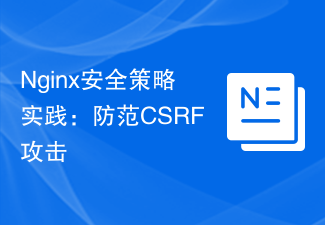 Java
Java javaTutorial
javaTutorial In-depth analysis: Practical guide for Struts framework in Web application development
In-depth analysis: Practical guide for Struts framework in Web application development
Title: From Principle to Practice: Exploring the Application of Struts Framework in Web Application Development
In today's era of rapid development of information technology, the development of Web applications It has become one of the important directions in the IT industry. In order to develop web applications more efficiently, developers usually choose to use some mature development frameworks. Among them, the Struts framework is one of the most popular development frameworks in the Java language and is deeply loved by developers. This article will deeply explore the principles and applications of the Struts framework, and demonstrate its application in Web application development through specific code examples.
1. Introduction to Struts Framework
Struts is a development framework based on the MVC (Model-View-Controller) pattern, designed to help developers better organize and manage the structure of Web applications. The core idea is to divide the application into three levels: model layer (Model), view layer (View) and control layer (Controller), thereby achieving code decoupling and reuse. In this way, developers can more easily develop and maintain functional modules.
2. Principle of Struts framework
- Model layer: The Model layer usually contains the business logic and data operations of the application. In the Struts framework, Java Beans can be used to represent business objects and implement data encapsulation and processing. Developers can write specific Java classes to implement business logic, and then connect these classes with the view layer and control layer through the Struts framework.
- View layer: The View layer is responsible for displaying data and interacting with users. In the Struts framework, JSP (Java Server Pages) is usually used to implement the view layer to dynamically display data on the page. Developers can write JSP pages to interact with the control layer through the Struts tag library to achieve dynamic display and interactive functions of the page.
- Controller layer: The Controller layer is the core of the entire application. It is responsible for receiving user requests, processing business logic, and returning results to the user. In the Struts framework, the Controller layer is implemented by the Action class of Struts. Developers can write specific Action classes, map requests to Action classes through configuration files, and implement user request processing and page jumps.
3. The practice of Struts framework
In order to better understand and apply the Struts framework, a simple example will be used to demonstrate its application in Web application development. road. We will implement a simple user login function, including the user entering the user name and password, clicking the login button for verification, and displaying different pages based on the verification results.
1. Write the Model layer
First, we need to write a Java Bean to represent user information, including username and password fields. The code example is as follows:
public class User {
private String username;
private String password;
// getter和setter方法略
}2. Write the View layer
Next, we need to write a JSP page to implement the user login form for the user to enter their user name and password. The code example is as follows:
<html>
<head>
<title>用户登录</title>
</head>
<body>
<form action="login.action" method="post">
用户名:<input type="text" name="username"><br>
密码:<input type="password" name="password"><br>
<input type="submit" value="登录">
</form>
</body>
</html>3. Write the Controller layer
Finally, we need to write an Action class to handle user login requests and verify them. The code examples are as follows:
public class LoginAction extends Action {
public ActionForward execute(ActionMapping mapping, ActionForm form, HttpServletRequest request, HttpServletResponse response) {
User user = (User) form;
if (user.getUsername().equals("admin") && user.getPassword().equals("admin123")) {
return mapping.findForward("success");
} else {
return mapping.findForward("failure");
}
}
}Conclusion
Through the above examples, we can see how the Struts framework can be used in Web application development. By dividing the application into three levels: Model, View and Controller, developers can organize and manage code more clearly and achieve efficient development and maintenance of functional modules. I hope this article will help you understand and apply the Struts framework!
The above is the detailed content of In-depth analysis: Practical guide for Struts framework in Web application development. For more information, please follow other related articles on the PHP Chinese website!
 Nginx安全策略实践:防范CSRF攻击Jun 10, 2023 am 10:00 AM
Nginx安全策略实践:防范CSRF攻击Jun 10, 2023 am 10:00 AM随着互联网的发展,Web应用程序已经成为我们日常生活中不可或缺的一部分。Web应用程序的开发通常涉及多个方面,例如设计、开发、运维、安全等等。其中,安全性是非常关键的,而CSRF攻击是Web应用程序中较为常见的安全漏洞之一。本文将围绕Nginx安全策略实践,介绍如何防范CSRF攻击。一、什么是CSRF攻击CSRF(Cross-siterequestfor
 基于Java的机器视觉实践和方法介绍Jun 18, 2023 am 11:21 AM
基于Java的机器视觉实践和方法介绍Jun 18, 2023 am 11:21 AM随着科技的不断发展,机器视觉技术在各个领域得到了广泛应用,如工业自动化、医疗诊断、安防监控等。Java作为一种流行的编程语言,其在机器视觉领域也有着重要的应用。本文将介绍基于Java的机器视觉实践和相关方法。一、Java在机器视觉中的应用Java作为一种跨平台的编程语言,具有跨操作系统、易于维护、高度可扩展等优点,对于机器视觉的应用具有一定的优越性。Java
 PHP程序中的迭代器最佳实践Jun 06, 2023 am 08:05 AM
PHP程序中的迭代器最佳实践Jun 06, 2023 am 08:05 AMPHP程序中的迭代器最佳实践迭代器在PHP编程中是一种非常常用的设计模式。通过实现迭代器接口,我们可以遍历一个集合对象中的元素,而且还可以轻松的实现自己的迭代器对象。在PHP中,迭代器模式可以帮助我们更有效地操作数组、列表等集合对象。在本文中,我们将介绍PHP程序中迭代器的最佳实践,希望能帮助同样在迭代器应用方面工作的PHP开发人员。一、使用标准迭代器接口P
 go-zero在微服务治理上的应用与最佳实践Jun 23, 2023 am 10:38 AM
go-zero在微服务治理上的应用与最佳实践Jun 23, 2023 am 10:38 AM作为一款轻量级的Go语言微服务框架,go-zero在微服务治理方面的应用和最佳实践已经成为了当前开发中不可忽视的重要部分。Go语言在进行分布式应用开发时,一般要使用微服务架构模式。在微服务架构中,服务之间的通信非常重要。要保证服务之间的通信的可靠性和高效性,就需要针对微服务治理进行优化。本文将探讨go-zero在微服务治理方面的应用与最佳实践,以期为开发者提
 使用PHP进行PDF生成的最佳实践May 23, 2023 am 09:02 AM
使用PHP进行PDF生成的最佳实践May 23, 2023 am 09:02 AMPDF已成为一种受欢迎的文件格式,广泛用于各种场景,包括电子书、报表和证明文件。在PHP中,可以使用多种库和工具来生成PDF文档,但是如何选择最佳实践?以下是使用PHP进行PDF生成的最佳实践:1.选择适当的库PHP中有多个PDF库可供选择,包括FPDF、TCPDF、mPDF和DOMPDF。FPDF是很早就存在的库之一,具有相当多的社区支持。TCPDF功能强
 前后端分离的PHP项目开发实践Jun 27, 2023 am 08:15 AM
前后端分离的PHP项目开发实践Jun 27, 2023 am 08:15 AM随着互联网的快速发展和数以亿计的用户日益增多,对于高质量、高性能的Web应用程序的需求也越来越大。在此背景下,前后端分离的PHP项目开发模式日益受到人们的青睐。本文将介绍前后端分离的PHP项目开发实践,包括开发流程、技术选型以及注意事项等方面的内容。一、前后端分离的概念前后端分离是指将Web应用程序的前端与后端分别开发、部署,并通过接口进行数据交互、业务逻辑
 Java实现的数据可视化方法和实践Jun 18, 2023 am 08:33 AM
Java实现的数据可视化方法和实践Jun 18, 2023 am 08:33 AM随着数据分析和处理的日益不断增长,数据可视化也成为了越来越重要的一个方向。对于企业和个人来说,如何将大量的数据转化为可视化的形式,是一项极为重要的技能。而在这个领域中,Java也是一种主流的可视化工具,它可以帮助用户更加快速、高效地进行数据处理和展示。本文将着重介绍Java实现数据可视化的各种方法和实践。一、基本的Java可视化工具Java中有很多可视化工具
 使用PHP进行数组操作的最佳实践Jun 06, 2023 am 10:30 AM
使用PHP进行数组操作的最佳实践Jun 06, 2023 am 10:30 AMPHP是一种广泛使用的服务器端脚本语言,可以通过许多不同的方式进行数组操作。本文将介绍我们编写PHP代码时的最佳实践,帮助您创建更高效、更美观、更可读的代码。1.使用数组函数而不是手动循环最好使用PHP数组函数,而不是手动循环数组来移动、操作或修改数据。PHP数组函数执行较快,具有更好的可读性和可维护性。下面是一些常用的PHP数组函数:array_push(


Hot AI Tools

Undresser.AI Undress
AI-powered app for creating realistic nude photos

AI Clothes Remover
Online AI tool for removing clothes from photos.

Undress AI Tool
Undress images for free

Clothoff.io
AI clothes remover

AI Hentai Generator
Generate AI Hentai for free.

Hot Article

Hot Tools

ZendStudio 13.5.1 Mac
Powerful PHP integrated development environment

Safe Exam Browser
Safe Exam Browser is a secure browser environment for taking online exams securely. This software turns any computer into a secure workstation. It controls access to any utility and prevents students from using unauthorized resources.

DVWA
Damn Vulnerable Web App (DVWA) is a PHP/MySQL web application that is very vulnerable. Its main goals are to be an aid for security professionals to test their skills and tools in a legal environment, to help web developers better understand the process of securing web applications, and to help teachers/students teach/learn in a classroom environment Web application security. The goal of DVWA is to practice some of the most common web vulnerabilities through a simple and straightforward interface, with varying degrees of difficulty. Please note that this software

SublimeText3 English version
Recommended: Win version, supports code prompts!

VSCode Windows 64-bit Download
A free and powerful IDE editor launched by Microsoft






